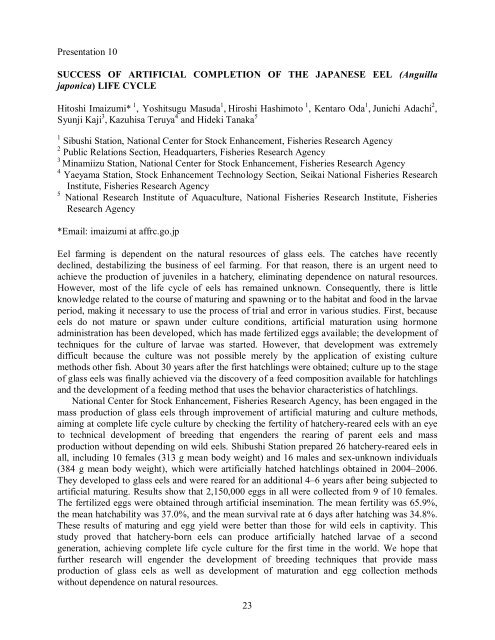Program and Abstracts(PDF)
Program and Abstracts(PDF)
Program and Abstracts(PDF)
Create successful ePaper yourself
Turn your PDF publications into a flip-book with our unique Google optimized e-Paper software.
Presentation 10<br />
SUCCESS OF ARTIFICIAL COMPLETION OF THE JAPANESE EEL (Anguilla<br />
japonica) LIFE CYCLE<br />
Hitoshi Imaizumi* 1 , Yoshitsugu Masuda 1 , Hiroshi Hashimoto 1 , Kentaro Oda 1 , Junichi Adachi 2 ,<br />
Syunji Kaji 3 , Kazuhisa Teruya 4 <strong>and</strong> Hideki Tanaka 5<br />
1 Sibushi Station, National Center for Stock Enhancement, Fisheries Research Agency<br />
2 Public Relations Section, Headquarters, Fisheries Research Agency<br />
3<br />
Minamiizu Station, National Center for Stock Enhancement, Fisheries Research Agency<br />
4 Yaeyama Station, Stock Enhancement Technology Section, Seikai National Fisheries Research<br />
Institute, Fisheries Research Agency<br />
5 National Research Institute of Aquaculture, National Fisheries Research Institute, Fisheries<br />
Research Agency<br />
*Email: imaizumi at affrc.go.jp<br />
Eel farming is dependent on the natural resources of glass eels. The catches have recently<br />
declined, destabilizing the business of eel farming. For that reason, there is an urgent need to<br />
achieve the production of juveniles in a hatchery, eliminating dependence on natural resources.<br />
However, most of the life cycle of eels has remained unknown. Consequently, there is little<br />
knowledge related to the course of maturing <strong>and</strong> spawning or to the habitat <strong>and</strong> food in the larvae<br />
period, making it necessary to use the process of trial <strong>and</strong> error in various studies. First, because<br />
eels do not mature or spawn under culture conditions, artificial maturation using hormone<br />
administration has been developed, which has made fertilized eggs available; the development of<br />
techniques for the culture of larvae was started. However, that development was extremely<br />
difficult because the culture was not possible merely by the application of existing culture<br />
methods other fish. About 30 years after the first hatchlings were obtained; culture up to the stage<br />
of glass eels was finally achieved via the discovery of a feed composition available for hatchlings<br />
<strong>and</strong> the development of a feeding method that uses the behavior characteristics of hatchlings.<br />
National Center for Stock Enhancement, Fisheries Research Agency, has been engaged in the<br />
mass production of glass eels through improvement of artificial maturing <strong>and</strong> culture methods,<br />
aiming at complete life cycle culture by checking the fertility of hatchery-reared eels with an eye<br />
to technical development of breeding that engenders the rearing of parent eels <strong>and</strong> mass<br />
production without depending on wild eels. Shibushi Station prepared 26 hatchery-reared eels in<br />
all, including 10 females (313 g mean body weight) <strong>and</strong> 16 males <strong>and</strong> sex-unknown individuals<br />
(384 g mean body weight), which were artificially hatched hatchlings obtained in 2004–2006.<br />
They developed to glass eels <strong>and</strong> were reared for an additional 4–6 years after being subjected to<br />
artificial maturing. Results show that 2,150,000 eggs in all were collected from 9 of 10 females.<br />
The fertilized eggs were obtained through artificial insemination. The mean fertility was 65.9%,<br />
the mean hatchability was 37.0%, <strong>and</strong> the mean survival rate at 6 days after hatching was 34.8%.<br />
These results of maturing <strong>and</strong> egg yield were better than those for wild eels in captivity. This<br />
study proved that hatchery-born eels can produce artificially hatched larvae of a second<br />
generation, achieving complete life cycle culture for the first time in the world. We hope that<br />
further research will engender the development of breeding techniques that provide mass<br />
production of glass eels as well as development of maturation <strong>and</strong> egg collection methods<br />
without dependence on natural resources.<br />
23



